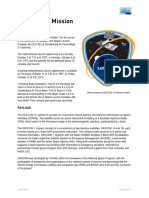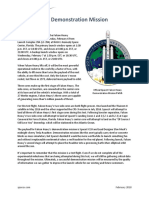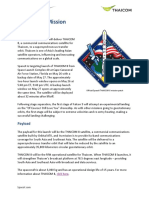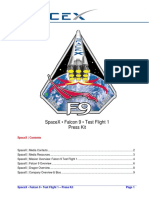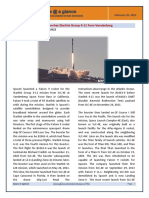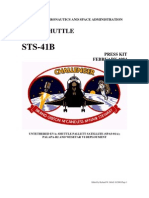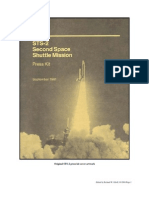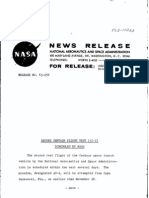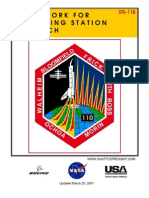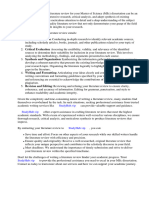Professional Documents
Culture Documents
Official Spacex Gps Iii Sv01 Mission Patch
Official Spacex Gps Iii Sv01 Mission Patch
Uploaded by
jaimeOriginal Description:
Original Title
Copyright
Available Formats
Share this document
Did you find this document useful?
Is this content inappropriate?
Report this DocumentCopyright:
Available Formats
Official Spacex Gps Iii Sv01 Mission Patch
Official Spacex Gps Iii Sv01 Mission Patch
Uploaded by
jaimeCopyright:
Available Formats
SpaceX is targeting Tuesday, December 18 for
launch of the United States Air Force’s first Global
Positioning System III space vehicle (SV) from
Space Launch Complex 40 (SLC-40) at Cape
Canaveral Air Force Station, Florida. The 26-minute
launch window opens at 9:11 a.m. EST, or 14:11
UTC. The satellite will be deployed to medium Earth
orbit approximately 1 hour and 56 minutes after
liftoff.
A 26-minute backup launch window opens on
Wednesday, December 19 at 9:07 a.m. EST, or
14:07 UTC.
Due to mission requirements, SpaceX will not attempt to
land Falcon 9’s first stage after launch. Official SpaceX GPS III SV01 Mission Patch
The United States’ Global Positioning System delivers positioning, navigation, and timing services
supporting vital U.S. and allied operations worldwide, and underpins critical financial, transportation, and
agricultural infrastructure that billions of users have come to depend on daily.
The United States Air Force’s first GPS III satellite will augment the current constellation of 31 operational
GPS satellites. This newest generation of GPS satellites is designed and built to deliver positioning,
navigation, and timing information with three times better accuracy, and up to eight times improved anti-
jamming capability. GPS is used by over four billion users and supports critical missions worldwide.
GPS is a National Security Space (NSS) mission, critical to national defense. In April 2016, SpaceX was
awarded its first NSS mission, GPS III SV01. SpaceX currently has an additional four GPS III missions on
contract, all of which will be launched on Falcon 9.
spacex.com December 2018
Hour/Min/Sec Events
- 00:38:00 SpaceX Launch Director verifies go for propellant load
- 00:35:00 RP-1 (rocket grade kerosene) loading underway
- 00:35:00 1st stage LOX (liquid oxygen) loading underway
- 00:16:00 2nd stage LOX loading underway
- 00:07:00 Falcon 9 begins engine chill prior to launch
- 00:01:00 Command flight computer to begin final prelaunch checks
- 00:01:00 Propellant tank pressurization to flight pressure begins
- 00:00:45 SpaceX Launch Director verifies go for launch
- 00:00:03 Engine controller commands engine ignition sequence to start
- 00:00:00 Falcon 9 liftoff
Hour/Min/Sec Events
00:01:04 Max Q (moment of peak mechanical stress on the rocket)
00:02:44 1st stage main engine cutoff (MECO)
00:02:48 1st and 2nd stages separate
00:02:50 2nd stage engine starts
00:03:22 Fairing deployment
00:08:16 2nd stage engine cutoff (SECO-1)
01:08:51 2nd stage engine restarts
01:09:37 2nd stage engine cutoff (SECO-2)
01:56:17 GPS III SV01 deployment
Space Launch Complex 40 at Cape Canaveral Air Force Station, Florida
SpaceX’s SLC-40 at Cape Canaveral Air Force Station is a world-class launch site that builds on a strong
heritage. The site, located at the north end of Cape Canaveral Air Force Station, was used for many
years to launch Titan rockets, among the most powerful in the U.S. fleet. SpaceX took over the facility in
May 2008.
The center of the complex is composed of the concrete launch pad and flame diverter system.
Surrounding the pad are four lightning towers, propellant storage tanks, and the integration hangar.
Before launch, Falcon 9’s stages and payload are housed inside the hangar. The payload is mated to the
Falcon 9 inside SLC-40’s hangar on the transporter erector. The rocket and payload are then rolled out
from the hangar to the launch pad and lifted to a vertical position.
SpaceX Contact | James Gleeson, Communications Director, 202-649-2633, [email protected].
Photos | High-resolution photos will be posted at flickr.com/spacex.
Webcast | Launch webcast will go live about 15 minutes before liftoff at spacex.com/webcast.
spacex.com December 2018
You might also like
- Interchange Intro Teacher's BookDocument352 pagesInterchange Intro Teacher's BookSarah Goncalves100% (12)
- SpaceX Falcon 9 Data SheetDocument10 pagesSpaceX Falcon 9 Data SheetvalstavNoch keine Bewertungen
- Starlink Press KitDocument2 pagesStarlink Press KitKumar Shashi0% (1)
- Eece Lesson Plan TemplateDocument11 pagesEece Lesson Plan Templateapi-370224084Noch keine Bewertungen
- SpaceX Nusantara SatuDocument2 pagesSpaceX Nusantara SatujaimeNoch keine Bewertungen
- Telstar 19 VantagepresskitDocument2 pagesTelstar 19 VantagepresskitJose MaurtuaNoch keine Bewertungen
- Nrol 76 PresskitDocument2 pagesNrol 76 PresskitSanjeev SahuNoch keine Bewertungen
- Saocom 1 ADocument2 pagesSaocom 1 AVictor PileggiNoch keine Bewertungen
- ZumapresskitDocument2 pagesZumapresskitJunior MirandaNoch keine Bewertungen
- Falconheavypresskit v1Document2 pagesFalconheavypresskit v1akhil gandasiriNoch keine Bewertungen
- Falconheavypresskit v1 PDFDocument2 pagesFalconheavypresskit v1 PDFsargentopepeNoch keine Bewertungen
- SpaceX ABS 2A:Eutelsat 117W BDocument2 pagesSpaceX ABS 2A:Eutelsat 117W BJaime Jarauta GasteluNoch keine Bewertungen
- Crs 11 Final Press KitDocument2 pagesCrs 11 Final Press KitCirca NewsNoch keine Bewertungen
- THAICOM 8 MissionDocument2 pagesTHAICOM 8 MissionJoeljar Enciso SaraviaNoch keine Bewertungen
- Spacex Orbcomm Press Kit Final2 PDFDocument2 pagesSpacex Orbcomm Press Kit Final2 PDFMuhammad FahmiNoch keine Bewertungen
- SpaceX Inmarsat 5-F4Document2 pagesSpaceX Inmarsat 5-F4jaimeNoch keine Bewertungen
- Bulgaria Sat 1 Press KitDocument2 pagesBulgaria Sat 1 Press KitjuniormirandaNoch keine Bewertungen
- SpaceX Arabsat 6ADocument2 pagesSpaceX Arabsat 6AJaime Jarauta GasteluNoch keine Bewertungen
- Crew Resupply Mission CRS2Document25 pagesCrew Resupply Mission CRS2tarx441Noch keine Bewertungen
- SpaceX CRS-2 Mission Press KitDocument25 pagesSpaceX CRS-2 Mission Press KitBob AndrepontNoch keine Bewertungen
- Spacex Orbcomm PDFDocument18 pagesSpacex Orbcomm PDFrtphokieNoch keine Bewertungen
- Sixth Starlink Mission Overview 0Document2 pagesSixth Starlink Mission Overview 0Valeria DurantiNoch keine Bewertungen
- Spacex - Falcon 9 - Test Flight 1 Press KitDocument10 pagesSpacex - Falcon 9 - Test Flight 1 Press KitFerry TriwahyudiNoch keine Bewertungen
- STARSHIPDocument2 pagesSTARSHIPBaatarsukh BatorNoch keine Bewertungen
- 02 PDFDocument4 pages02 PDFsaju_s_rajNoch keine Bewertungen
- Space Shuttle Mission STS-41BDocument32 pagesSpace Shuttle Mission STS-41BAviation/Space History LibraryNoch keine Bewertungen
- SA-6 Press KitDocument53 pagesSA-6 Press KitBob Andrepont100% (1)
- SA-5 Press KitDocument53 pagesSA-5 Press KitBob AndrepontNoch keine Bewertungen
- Space Shuttle Mission STS-2Document65 pagesSpace Shuttle Mission STS-2Aviation/Space History LibraryNoch keine Bewertungen
- NASA 167413main KodiakstarDocument2 pagesNASA 167413main KodiakstarNASAdocumentsNoch keine Bewertungen
- Atlas Centaur AC-2 Press KitDocument30 pagesAtlas Centaur AC-2 Press KitBob AndrepontNoch keine Bewertungen
- Atlas Centaur AC-1 Press KitDocument15 pagesAtlas Centaur AC-1 Press KitBob Andrepont100% (1)
- Eigth Scout Development Flight Press KitDocument6 pagesEigth Scout Development Flight Press KitBob AndrepontNoch keine Bewertungen
- Spaceflightnow-ComDocument10 pagesSpaceflightnow-Comjaume Marí RibasNoch keine Bewertungen
- Space Launch System SLS NASADocument7 pagesSpace Launch System SLS NASAmsgetsemaniNoch keine Bewertungen
- Space Shuttle Mission STS-30Document42 pagesSpace Shuttle Mission STS-30Aviation/Space History LibraryNoch keine Bewertungen
- As 203 Press KitDocument33 pagesAs 203 Press KitBob Andrepont100% (1)
- Week 9-DB AssignmentsDocument3 pagesWeek 9-DB AssignmentsmariyaNoch keine Bewertungen
- Falcon 9 v1.2Document9 pagesFalcon 9 v1.2Kei OufagNoch keine Bewertungen
- STS-110 Press KitDocument97 pagesSTS-110 Press KitBob AndrepontNoch keine Bewertungen
- Space Shuttle Mission STS-60Document66 pagesSpace Shuttle Mission STS-60Aviation/Space History LibraryNoch keine Bewertungen
- Space Exploration Technologies CorporationDocument11 pagesSpace Exploration Technologies CorporationPaul SpivakNoch keine Bewertungen
- V158 - 04 - Feb - 26 PDFDocument9 pagesV158 - 04 - Feb - 26 PDFDavid ZusimanNoch keine Bewertungen
- Saturn V Apollo Launch Operations PlanDocument34 pagesSaturn V Apollo Launch Operations PlanBob Andrepont100% (3)
- NASA Facts John F. Kennedy Space CenterDocument8 pagesNASA Facts John F. Kennedy Space CenterBob AndrepontNoch keine Bewertungen
- RCA Satcom 1R Press KitDocument8 pagesRCA Satcom 1R Press KitBob AndrepontNoch keine Bewertungen
- Falcon Heavy - Research PaperDocument7 pagesFalcon Heavy - Research PaperpesticidecontrollerNoch keine Bewertungen
- STS-1 Press KitDocument51 pagesSTS-1 Press KitBob Andrepont100% (1)
- TECHNICAL Report of Falcon 9Document27 pagesTECHNICAL Report of Falcon 9Varun mNoch keine Bewertungen
- Apollo 7 Press KitDocument103 pagesApollo 7 Press KitBob AndrepontNoch keine Bewertungen
- Peregrine Mission OneDocument92 pagesPeregrine Mission OneDr. Amos ArinyNoch keine Bewertungen
- Space Launch System Core StageDocument2 pagesSpace Launch System Core StageHasannudin BisriNoch keine Bewertungen
- Saturn V Payload Planner's GuideDocument72 pagesSaturn V Payload Planner's GuideBob Andrepont100% (1)
- 171st Ariane Mission Press KitDocument10 pages171st Ariane Mission Press KitAaron Monk100% (1)
- Manned Mars Landing: Presentation to the Space Task Group - 1969From EverandManned Mars Landing: Presentation to the Space Task Group - 1969Noch keine Bewertungen
- 3M PSD Active Hearing Catalogue (LR)Document52 pages3M PSD Active Hearing Catalogue (LR)David BaylissNoch keine Bewertungen
- CATALOGO Vulcraft DeckcatDocument100 pagesCATALOGO Vulcraft DeckcatRicardo Jesus Mallma Cubas100% (1)
- Presentation 1Document30 pagesPresentation 1munna_bhai8260% (1)
- Transaction ID - DocxmakDocument1 pageTransaction ID - DocxmakArijeet GhoshNoch keine Bewertungen
- FINAL Standard Chartered BankDocument9 pagesFINAL Standard Chartered BanknareshmanglaniNoch keine Bewertungen
- Pro30 RealisticDocument20 pagesPro30 RealisticDan (yo4cvv)Noch keine Bewertungen
- Catalago LW541F Construction Machinery PDFDocument154 pagesCatalago LW541F Construction Machinery PDFAnonymous 9fCAFynM100% (1)
- Micron Serial NOR Flash Memory: 3V, Multiple I/O, 4KB Sector Erase N25Q064A FeaturesDocument81 pagesMicron Serial NOR Flash Memory: 3V, Multiple I/O, 4KB Sector Erase N25Q064A FeaturesalfredosnNoch keine Bewertungen
- Text Why Is Emotional Intelligence Important For TeensDocument2 pagesText Why Is Emotional Intelligence Important For Teensno nameNoch keine Bewertungen
- SHS Applied Eco Module - 21 and 22Document8 pagesSHS Applied Eco Module - 21 and 22Ronald AlmagroNoch keine Bewertungen
- Literature Review Example MSCDocument6 pagesLiterature Review Example MSCdlihimwgf100% (1)
- IB History HL Essay - Emily DickinsonDocument7 pagesIB History HL Essay - Emily DickinsonAdelaide HowlandNoch keine Bewertungen
- Series 45: Axial Piston Open Circuit Pumps Repair ManualDocument32 pagesSeries 45: Axial Piston Open Circuit Pumps Repair ManualJose Manuel Barroso PantojaNoch keine Bewertungen
- QA QC Plan - WoodcrestDocument139 pagesQA QC Plan - WoodcrestthuanNoch keine Bewertungen
- Structural DesignDocument47 pagesStructural DesignKenshin Himura100% (3)
- Department of Education: Republic of The PhilippinesDocument1 pageDepartment of Education: Republic of The Philippinesmyra duyagNoch keine Bewertungen
- Chapter 30: ElectromagnetismDocument20 pagesChapter 30: ElectromagnetismahmedhohantyNoch keine Bewertungen
- Solar Power PDFDocument55 pagesSolar Power PDFFahad JadiyaNoch keine Bewertungen
- Indirect-Fired Water Heaters: Installation, Operation & Maintenance ManualDocument28 pagesIndirect-Fired Water Heaters: Installation, Operation & Maintenance ManualBensmatElHouariNoch keine Bewertungen
- 14 - Appendix MSD PDFDocument43 pages14 - Appendix MSD PDFNanban MadhavanNoch keine Bewertungen
- Advanced in Carbohydrate Chemistry and BiochemistryDocument447 pagesAdvanced in Carbohydrate Chemistry and BiochemistryVega FraamoreNoch keine Bewertungen
- The Effect of The Running and Blok LearningDocument23 pagesThe Effect of The Running and Blok LearningSyifa Hifziatu RahmahNoch keine Bewertungen
- Glavpooltorg.su Тепловые насосы NORM - инструкция по применениюDocument32 pagesGlavpooltorg.su Тепловые насосы NORM - инструкция по применениюIon RotariNoch keine Bewertungen
- RO400FC RO300FC Specifications - V3.2Document6 pagesRO400FC RO300FC Specifications - V3.2bogdantn98Noch keine Bewertungen
- The Dark Side of The Technological BoomDocument7 pagesThe Dark Side of The Technological BoomTuyền PhạmNoch keine Bewertungen
- Ruiz & Sodusta - School Based Management - Slide DeckDocument94 pagesRuiz & Sodusta - School Based Management - Slide DeckGenevieve RufinoNoch keine Bewertungen
- 12 - HUMSS and STEM Ne Edit Na TotooDocument10 pages12 - HUMSS and STEM Ne Edit Na TotooFreya GandaNoch keine Bewertungen
- Record Keeping PPPDocument18 pagesRecord Keeping PPPremelroseNoch keine Bewertungen









